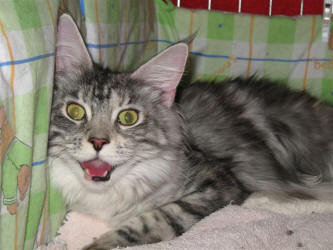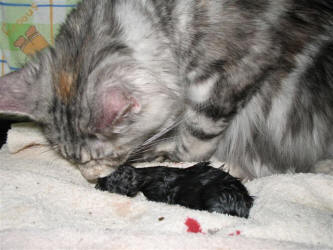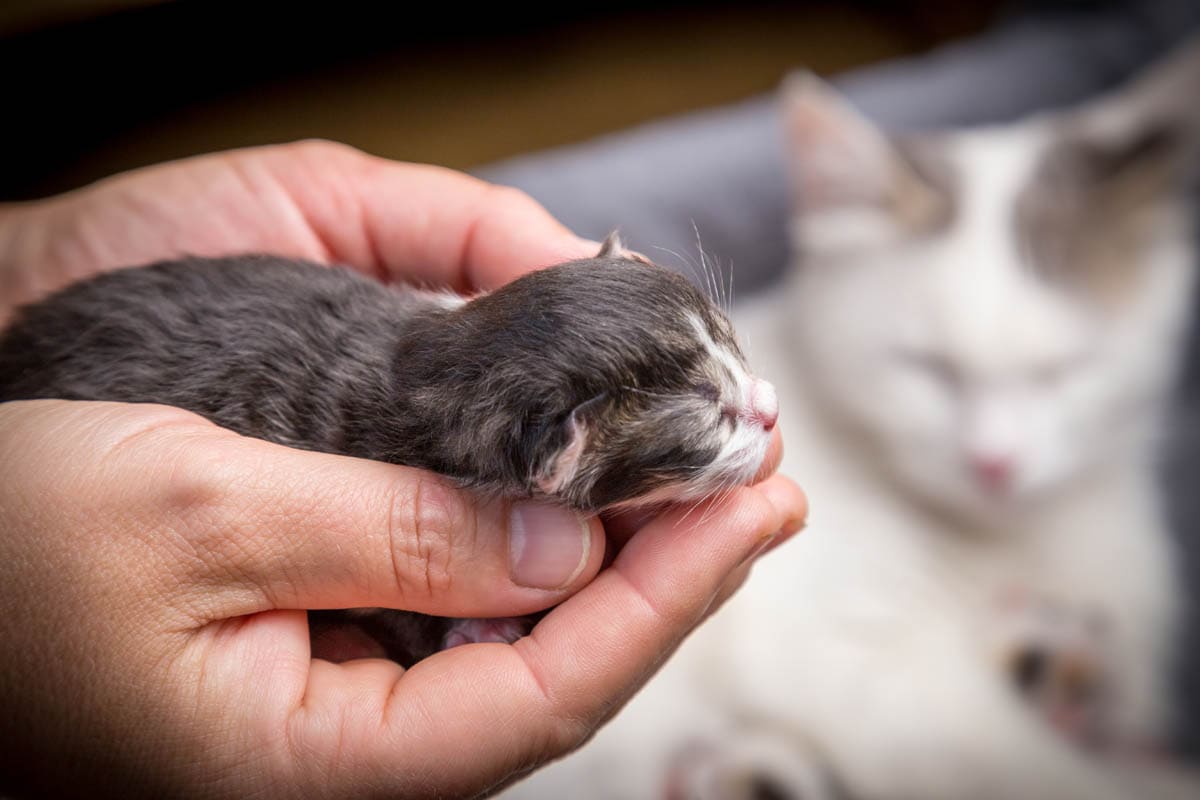Cat birth at a glance
|
Signs of labour in cats
- Increase in size of mammary glands – The mammary glands increase in size during the last week of gestation.
- Milk production – Approximately two days before the queen gives birth; milk can be expressed from the nipples.
- Nesting – The queen will spend more time in her nesting box as birth approaches.
- A decrease in temperature – Normal temperature in a cat is 100 – 102.5°F (37.7 – 39.1°C). A day or two before birth, her temperature drops to 99°F (37.2°C).
- Change in behaviour – During the last week or so, your queen may become either reclusive (possibly seeking out a secluded place), or more affectionate, especially if she is particularly close to one caregiver.
- Loss of appetite.
- Restlessness and pacing.
- Frequent genital licking.
- Clear discharge from the vagina.
The cat’s uterus (womb) has two horns, which come together with a central uterine cavity. The cervix is at the end of the uterine cavity and is closed during pregnancy. Developing kittens lie within the horns and are attached to the mother via the umbilical cord. The umbilical cord is attached to the placenta, which joins the mother and kitten together. The role of the placenta is to transport nourishment from the mother and to take waste away from the fetus (unborn kitten).
Preparation
During the last week of pregnancy, place the kittening box in a warm, quiet, draft-free room (this is important as newborn kittens are unable to regulate their body temperature for the first three weeks of life),. The room should be off-limits to children and other pets. She should be encouraged to sleep in this box.
Food, water, and a litter tray also need to be placed in this room.
Line the nesting box with old newspapers—which can easily be changed—or an old blanket. Make sure that the blanket isn’t going to snag the kittens’ claws.
Supplies
- Kittening box
- Several pairs of sterile surgical gloves
- Eyedropper or syringe to aspirate secretions from the mouth and nose
- Dental floss or cotton thread to tie the umbilical cord
- Antiseptic (Betadine, diluted to the colour of weak tea) to apply to the umbilical
cord stumps - Infant nasal cleaner
- Scissors
- Clean towels
- Your own vet’s phone number as well as an emergency veterinarian’s phone number
- Kitten milk replacer (speak to your veterinarian)
- Source of warmth for the kittens such as a hot water bottle wrapped in a blanket
- Cat carrier
Stages of labour
First stage – 12 hours or more
- Birth begins with the onset of uterine contractions. During this stage, the cervix begins to dilate (open). A clear, odourless discharge from the vagina is usually apparent. This discharge is known as the mucus plug and was in the cervix during pregnancy, sealing the uterus from the vagina. As the first stage progresses, contractions will become closer and closer together.
Second stage – 5 minutes to 1 hour
- Contractions become stronger and closer together, and the cervix is fully dilated. The queen is ready to give birth. The kitten moves down the birth canal. Pressure on the cervix initiates the mother’s urge to push. You may see her visibly straining to push the kitten out. The kitten’s water bag (or bubble) is visible at the vulva; which bursts, the queen will clean up most of this liquid. It typically takes around three pushes for the kitten to be delivered.
- The queen will tear and lick the membrane from the face and body, which will stimulate breathing. In the event, the queen doesn’t remove the membrane from the kitten’s mouth and nose, you should do this for her and follow-up by gently rub the kitten with a soft towel to stimulate breathing. Use the infant nasal cleaner to remove debris from the mouth and nose if necessary.
- The second stage usually takes around 5 minutes to 1 hour. If the kitten hasn’t been born after an hour, call your veterinarian.
Third stage
- Immediately following the kitten’s birth, the placenta is delivered. Once the queen has cleaned the kitten and breathing has commenced, the queen will chew the umbilical cord in two and, quite often, will eat the placenta.
- After the delivery of a kitten, you must pay attention to the delivery of the placentas. Have a pen and paper close and make a note of how many placentas have been delivered. This is important because a retained placenta will lead to infection, which is life-threatening.
If the mother fails to chew the umbilical cord, you will have to do this. Tie a piece of dental floss around the cord no closer than 1 inch from the kitten’s body and snip it with a pair of sterile scissors. Be careful not to pull on the umbilical cord while doing this as it could result in an umbilical hernia.
Use the infant nasal cleaner to remove debris from the mouth and nose if necessary.
The kitten usually crawls towards a nipple and begins to nurse which helps to stimulate the uterus to contract, assisting with the delivery of the next kitten. If the kitten hasn’t moved to a nipple and begun to nurse, carefully place the kitten on one of her nipples.




Contented mum with babies.
Resumption of labour
Once the kitten is cleaned up, the queen will push it towards a nipple. Contractions will resume, and delivery of the next kitten will usually happen between ten minutes to an hour after the delivery of the previous kitten.
All in all, it may take between 2 – 6 hours to deliver a litter of kittens.
Interrupted labour
There can be a significant gap between kitten deliveries which is known as interrupted labour. The queen will cease straining and attend to the kittens she has delivered by cleaning and nursing them. She may eat some food, if it is offered, and will appear to have completed labour. After a period of rest (interrupted labour may last as long as 24-36 hours), labour will resume, and the rest of the litter will be delivered. It would be worth speaking to your vet if no kittens have been delivered in four hours and you suspect your queen may have gone into interrupted labour.
When to call a veterinarian
There are many possible problems your queen may encounter during birth to cover in this article. A week before the due date, take the cat to the veterinarian for a final check-up and discuss the birth and potential problems. The vet will be able to advise what is ‘normal’ and what requires veterinary attention.
- Gestation which lasts longer than 70 days.
- First stage labour lasting longer than 12 hours.
- Twenty minutes of intense labour and straining without producing a kitten.
- Straining for ten minutes while a fetus or a fluid-filled bubble is visible in the birth canal.
- Acute depression.
- Fever (above 103°F).
- Sudden discharge of bright, red blood from the vagina lasting longer than 10 minutes.
- Thick, black, foul-smelling discharge from the vagina.
- If the queen has chewed the cord close to the body, microabscesses can develop and spread bacteria into the bloodstream. Prophylactic administration of a long-acting antibiotic will be necessary.
How involved should you be?
The majority of cats are quite capable of giving birth without assistance, take a backseat and do not interfere unless a problem occurs.
Too much involvement can be stressful for the queen. Allow her to give birth to her kittens and care for them as newborns as undisturbed as possible.
How soon after giving birth can a cat go into heat?
It is possible for a cat to go into heat, mate, and become pregnant within 6-8 weeks of giving birth.

